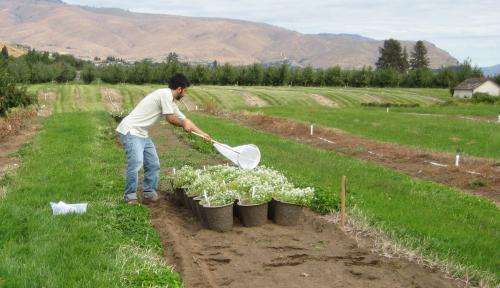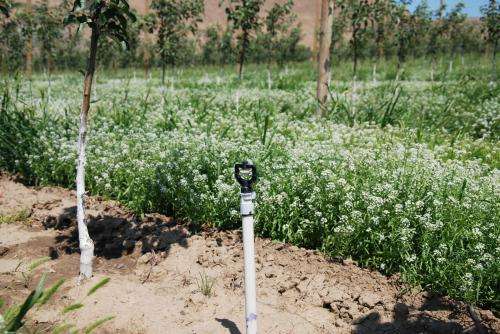Flower power fights orchard pests

Washington State University researchers have found they can control one of fruit growers' more severe pests, aphids, with a remarkably benign tool: flowers. The discovery is a boon for organic as well as conventional tree fruit growers.
The researchers recently published their study in the journal Biological Control. They found that plantings of sweet alyssum attracted a host of spiders and predator bugs that in turn preyed on woolly apple aphids, a pest that growers often control with chemical sprays.
"The results were striking," said Lessando Gontijo, who led the research project while a doctoral student in the WSU Department of Entomology. "After one week, aphid densities were significantly lower on trees adjacent to flowers than on control plots, and these differences were maintained for several weeks."
To select an appropriate flower for the study, the researchers screened six candidates, including marigolds and zinnias. They chose sweet alyssum because it attracted the greatest number of hoverflies, or syrphids, which have larvae that often feed on aphids. Hoverflies and other insects are attracted to flowers because they can find food in the form of pollen and nectar.
Researchers compared plots of apple trees with sweet alyssum to plots without flowers. While the sweet alyssum attracted hoverflies, as desired, Gontijo and colleagues found few hoverfly larvae, showing that the hoverflies had only a marginal effect on the aphid population.
The mystery of the disappearing aphids seemed solved when the researchers found a diverse community of spiders and predatory insects in the plots with sweet alyssum. But was it really the flowers that attracted aphid predators? The scientists sprayed protein markers on the sweet alyssum and later captured insects and spiders at a distance from the flower plots. Many of the insects and spiders tested positive for the proteins, proving that they had visited the flowers.

"The woolly apple aphid is surprisingly damaging for an aphid, attacking tree shoots and roots," said Betsy Beers, an entomologist based at WSU's Tree Fruit Research and Extension Center in Wenatchee and Gontijo's mentor and co-author on the paper. "These aphids also secrete a sticky liquid called honeydew, which can coat the apples, causing much annoyance during harvest."
The aphids were previously kept at bay when orchardists sprayed pesticides to control codling moths. Since the phase-out of organophosphate insecticides, though, the woolly apple aphid has been making a comeback in central Washington and elsewhere.
The researchers state that the use of sweet alyssum for biological control can be easily integrated with standard orchard-management practices and should be especially appealing to organic growers, who have fewer insecticide options.
More information: The article, "Flowers promote aphid suppression in apple orchards," was published in the July 2013 edition of Biological Control and is available online at www.sciencedirect.com/science/ … ii/S104996441300056X
Provided by Washington State University



















